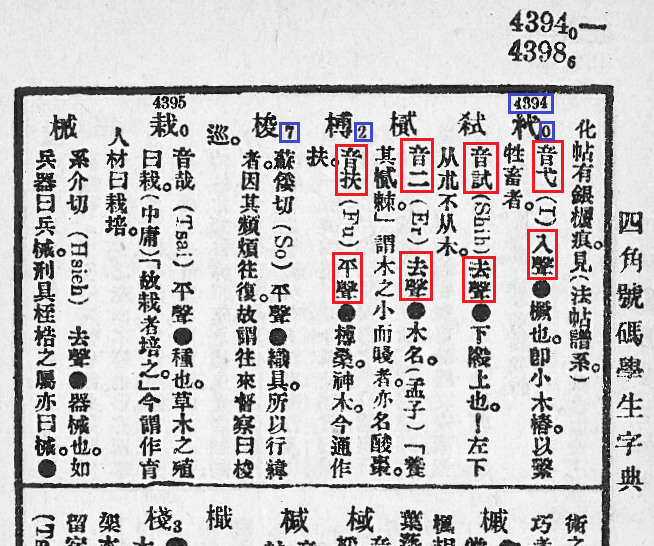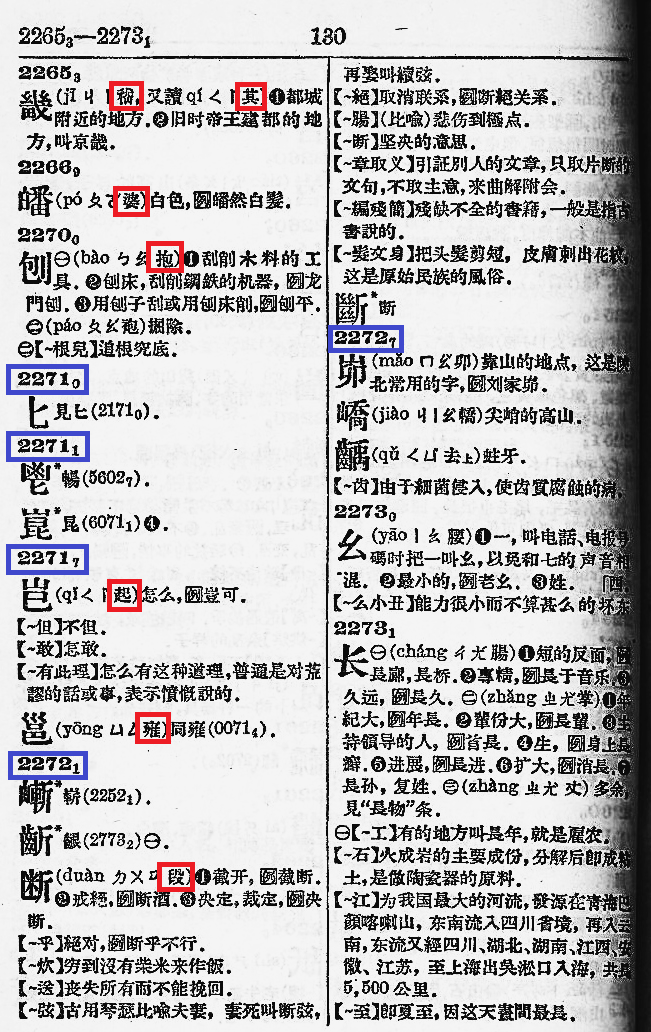The four-corner method (today called sijiao haoma chazi fa 四角號碼查字法) is an indexing method for Chinese characters developed in 1925 by Wang Yunwu 王雲五 (1888-1979) and published in the periodical Dongfang zazhi 東方雜志 / The Eastern Miscellany, 23/3 (1926), pp. 95-103. It was first used in the dictionary Sijiao haoma xuesheng zidian 四角號碼學生字典 (ed. by Lu Erkui 陸爾奎 and Fang Yi 方毅), published in 1928 by the Commercial Press in Shanghai.
In 1964, the Special Working Group for the Arrangment of Character Look-Up Methods (Hanzi chazifa zhengli gongzuo zu 漢字查字法整理工作組) amended the system in six points (the so-called gaige cao'an 改革草案), so that it was also useable for simplified characters. It was used by several dictionaries, like Sijiao haoma xin cidian 四角號碼新詞典 (ed. by Shangwu yinshuguan 商務印書館, Shanghai: Shangwu yinshuguan, 1950), and older versions of the Xiandai hanyu cidian 現代漢語詞典 and Cihai 辭海. The system has disappeared from such popular dictionaries since the early 1990s.
The four-corner method can also be used to input Chinese characters in electronical texts.
This method attributes a number to each of the four corners of a character, depending on the shape of the "brush stroke". It allows the user to search for characters without knowing the pronunciation or the radical of the character. Quite a number of specialized lexicons and indexes use this method, but it is not so widespread because the finding of the correct number is not always very easy. In addition to the complexity of rules, there are sometimes deviating interpretations as to the number given to certain structures. Books using the four-corner system often have an appendix including an alternative to the complicated system. The above-mentioned Sijiao haoma xuesheng zidian, for instance, has a stroke number index (bishu suoyin 筆數索引) appended (at least in the 8th edition), likewise the 1958 edition of the Sijiao haoma xin cidian. The latter provides the user also with a Pinyin index.
Each "corner" of a character is given a number from 0 to 9, with the order top left — top right — bottom left — bottom right. These numbers represent certain graphical elements:
| 0 | the top element 亠 |
| 1 | horizontal strokes |
| 2 | vertical strokes |
| 3 | dots |
| 4 | crosses (vertical and diagonal) |
| 5 | double-crossed lines |
| 6 | boxes |
| 7 | corners |
| 8 | diverging structures of two parts |
| 9 | structures with three diverging parts |
In addition to these basic structures, 1 also stands for elements tending to the right, 2 for elements tending to the left, 3 also for slants to the lower right, and so on. The exact rules can be found in the table below.
A mnemonic poem helps to remember the rules of the four-corner system, used in the Sijiao haoma xin cidian:
| 横一垂二三點捺, heng yi, chui er, san dian na, 叉四插五方框六。 chai si, cha wu, fang kuang liu, 七角八八九是小, qi jiao, ba ba, jiu shi xiao, 點下有横變零頭。 dian xia you heng, bian ling tou. |
| "Horizontal is 1, hanging is 2, and 3 stands for dots and slants, Crosses 4, a stroke more 5, and boxes number 6. 7 corners, 8 like 八 'eight', and 9 like 小 'small'. Dot above a horizontal stroke is 0 in the front." |
The difficulty of this system is that the user has to make himself free from semantical structures of characters. Elements like 广 or the part ![]() in the character 力 can be split up in several parts, while the lower part of 木 is seen as one unit.
in the character 力 can be split up in several parts, while the lower part of 木 is seen as one unit.
 |
In case one unit covers the whole width of a character, the upper left or lower left number counts for the unit, while the right side is given the number 0.
 |
0 thus stands for 亠 and for an element covering the whole upper or whole lower part of a character. It also stands for corners without any stroke.
 |
In case a character consists of a surrounding structure, like 囗, 門, 鬥 or 行, these structures are only used for the two upper numbers. The two lower numbers are taken from the inside structures (或 in 國, 十 in 田, 才 in 閉 or 市 in 鬧, 圭 in 街). This rule is only valid if 囗, 門 (门) and 鬥 enclose the whole character. It is not valid for characters like 苗, 簡 or 潤.
 |
Even such a sophisticated system does not mean that there are characters with the same four-digit number. In order to make possible further distinction between characters, an additional number (fuhao 附號) is given. This additional number is derived from the shape of the stroke located directly upwards of the lower right corner (the fourth number). If this stroke has already been used for the number of the upper right corner, it is 0.
 |
In case the fifth number is still the same in several characters, a sixth number can be created, derived from the total number of horizontal strokes in the character. In this case, too, semantic considerations do not count—each horizontal element counts.
 |
 |
Page from the dictionary Sijiao haoma xuesheng zidian from 1928. The small blue numbers to the right lower corner of the characters (in blue boxes) are the additional numbers. The red boxes indicate pronunciation by presenting a homophone (zhiyin 直音 system), including the tone pitch (lower red boxes). |
 |
The beginning of the "Three-Characters Classic" Sanzijing 三字經, with four-corner number for each character, from Wang Yunwu's 王雲五 publication of his "invention" in the journal Dongfang zazhi 東方雜志 1926. |
 |
Page from the Sijiao haoma xin cidian 四角號碼新詞典 (1950). The four-corner numbers are indicated by blue boxes. The red ones refer to a system indicating pronunciation by presenting a homophone. |